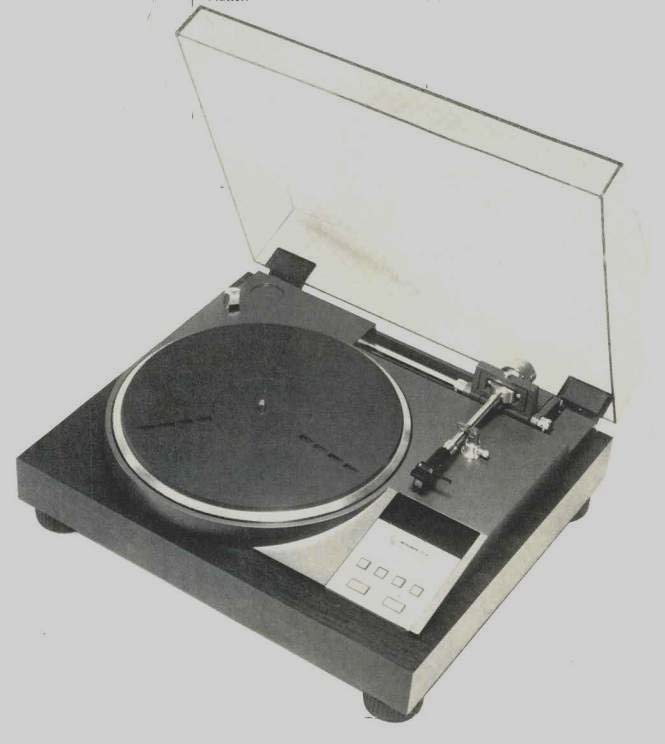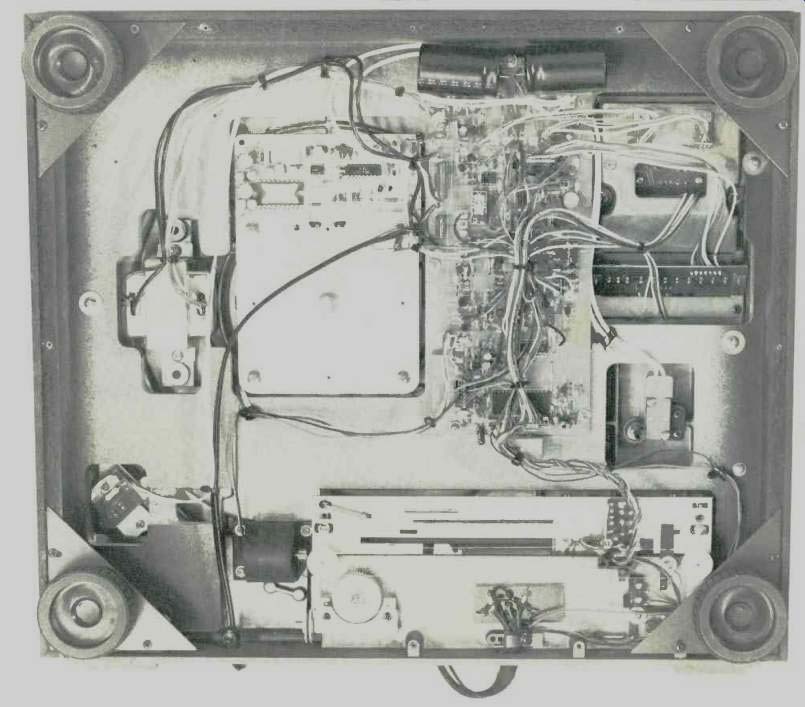Manufacturer's Specifications:
Type: Two speed.
Motor Type: Direct drive, d.c. servo, quartz PLL.
Wow & Flutter: 0.04 percent W rms.
Rumble: 78 dB (DIN "B").
Platter: Aluminum diecast, (1.48 kg). 3.3 lbs.
Arm: Straight stainless tube.
Headshell: Magnesium diecast.
Dimensions: 19 in. (48.26 cm) x 16 1/4 in. (41.27 cm) x 5 3/4 in. (14.60 cm).
Weight: 33 lbs. (14.85 kg).
Price: $690.00.

The Mitsubishi LT-30 must take its place among the top few turntables
now available.
During the past two years, a surprising number of straight-line tracking turntables have appeared on the scene, and more are on the way. Most use optical sensors to keep the cartridge aligned, while the arm is moved by a separate slide motor. Each revolution of the record brings the stylus one groove nearer the center and thus tends to pivot the arm a fraction of a degree.
This operates the sensors which in turn activate the motor to move the arm. The technique is now firmly established, and, provided the mechanical parts are properly designed and engineered, it can work very well indeed. Whether the advantages of tangential tracking are more theoretical than real is debated in some circles, but it certainly disposes of the anti-skating complications--no magnets, springs, or hanging wire outriggers! There is another very real advantage: Most turntables of this type are a real delight to use because of the simple, positive cueing.

The model selected for review, the Mitsubishi LT-30, is a trifle larger than conventional turntables, measuring 19 inches by 16 1/4 inches by 5 3/4 inches. The motor board is made from diecast aluminum, styled in charcoal gray and silver, and it contrasts with the wooden base covered with an attractive rosewood vinyl veneer. The unit stands on four large isolating feet. The arm assembly is mounted on nylon rollers which move on two parallel rods at the rear, and it is provided with both height and tracking angle adjustments. The arm itself is made from stainless steel and measures 6 1/8 inches from pivot center to stylus. It is a statically balanced type with a calibrated balance weight at the rear.
Over on the left-hand side, near the platter, is a light, mounted in a plastic deflector, which functions with a sensing circuit to gauge the record size and determine the speed and correct lead-in position of the arm. Small prisms mounted on the turn table mat project through the platter to receive light from the aforementioned deflector. If a 12-inch record is placed on the platter, all the prisms are covered so a logic circuit switches the speed to 33 rpm and sets the arm lead-in position accordingly. A small 45-rpm record will not cover all the prisms, so the speed would automatically be changed and the arm would move to the appropriate position.
At the front of the unit, on the right, is a control panel containing six push buttons for speed, repeat, cue, start, stop and platter on-off. This last switch allows the platter to rotate without the arm moving, thereby facilitating record cleaning. Just behind the group of push buttons is an illuminated display showing the speed (33 or 45 rpm), quartz-lock indication, direction of the arm, and tracking error. If tracking is correct, a vertical line illuminates. If one of the associated arrows lights up more than momentarily, the arm must be adjusted accordingly. The motor is a direct-drive type, servo controlled by a PLL circuit.
In-Use Tests
For test purposes, an Adcom XC-E moving-coil cartridge was mounted on the headshell and the tracking force set to 1.7 grams. After checking the operation of the unit, adjusting the height and so on, wow and flutter was measured. The combined figure was a very good 0.035 percent (DIN 45-507). Rumble was a very low 64 dB (ARRL), and the arm resonance was at 8 Hz with a rise of 3.5 dB. Calibration of the balance weight was found to be accurate within 5 percent. Speed was right on the nose and showed no measurable drift.
To operate, the start button is depressed and the arm moves over until it lowers the stylus into the lead-in groove. At the end of play, the arm returns to its rest, taking about 20 seconds. If you keep the start button depressed, the arm will continue to move (at half speed beyond the lead-in groove) until your finger is removed and then a touch of the cue button will cause the arm to be lowered. If you want to backtrack, it is only necessary to press the stop button and the arm will rise and move into reverse until the cue button is pressed. Thus, the arm is nicely controlled in both directions, smoothly and without fuss, bounce or backlash. The unit was used to transfer a number of record selections to tape for a local college. This exercise required accurate cueing with a speech commentary, and the LT-30 proved to be a real pleasure to use.
Because of the logic control circuit with the platter sensors, colored discs, 12-inch 45-rpm or 10-inch records cannot be used in the full automatic mode, and the speed must be set manually. According to Mitsubishi, transparent discs can be played if a circle of black paper is placed underneath. I tried a Scotch anti-static foam pad and had no problems.
The unit was relatively insensitive to acoustical feedback, and the base could be knocked quite hard before mistracking occurred. Unquestionably, the Mitsubishi LT-30 must take its place among the top few turntables now available and it well deserves a really high-grade cartridge.
-- George W. Tillett
(Source: Audio magazine, Apr. 1982)
also see:
Linear Tracking Turntables (June 1981)
Mitsubishi DP-EC1 direct-drive turntable (ad, June 1977)
= = = =